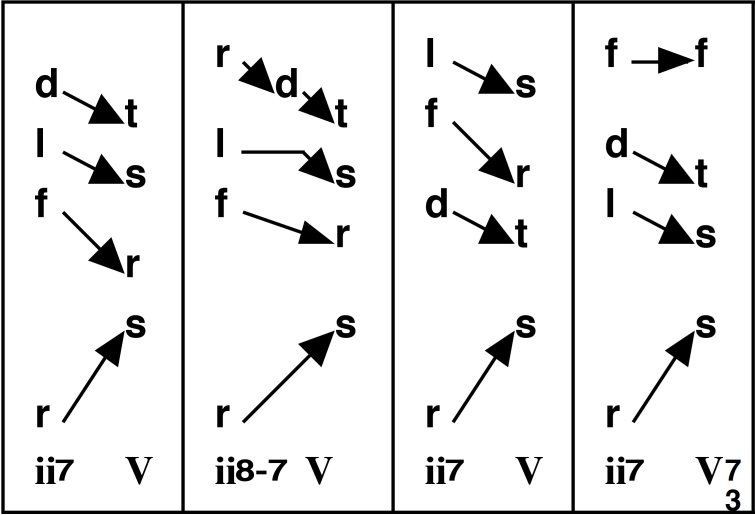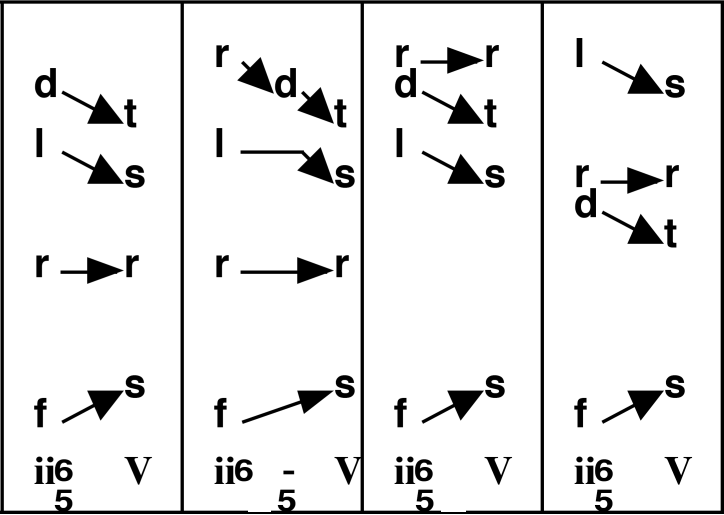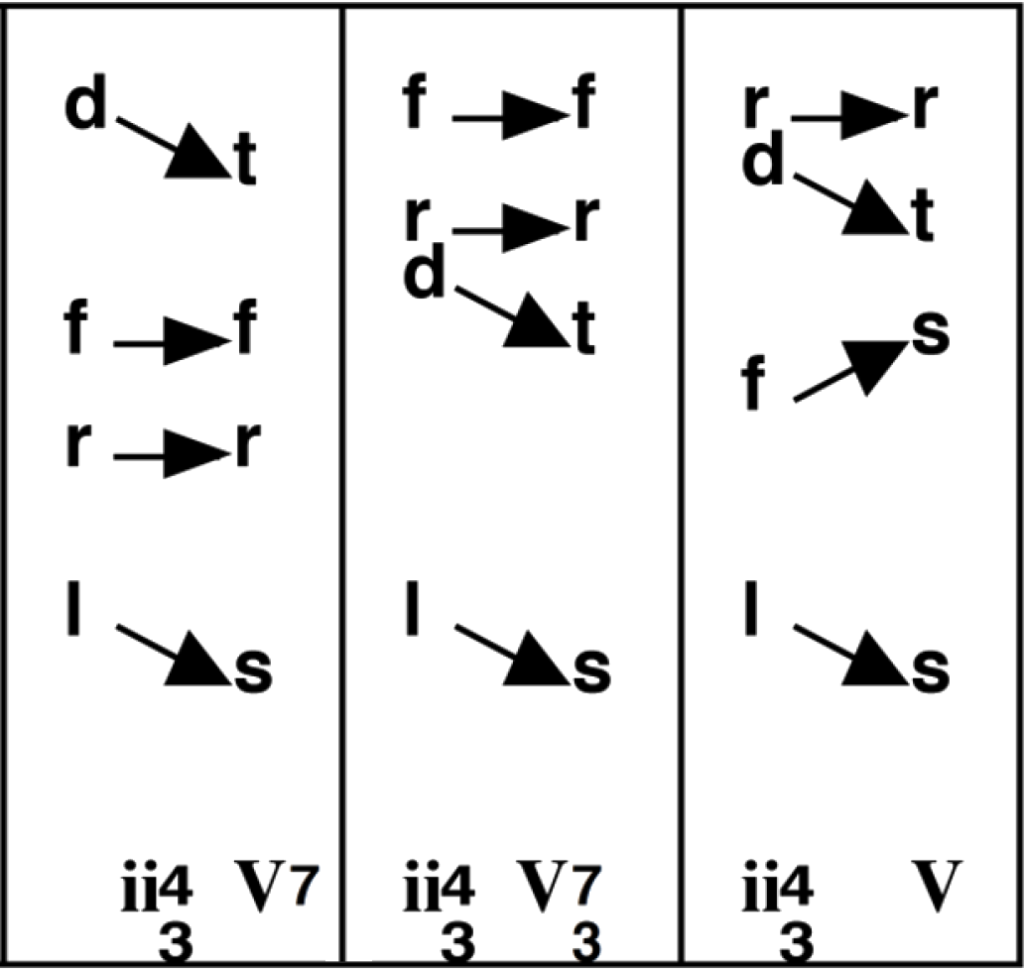13 Diatonic Seventh Chords
Diatonic seventh chords can be built on dominant chords (V and viio) and non-dominant chords (I, ii, iii, IV, and vi).
Diatonic seventh chords function the same way as their earlier triadic forms, utilizing the falling 5th, falling 3rd, and rising 2nd functional root movements.
The 7th of the chord resolves down by step in the same way as the 7th of the dominant seventh chord (Dominant Seventh Chord). Similarly, inversions of all the diatonic seventh chords resolve with the same tendencies as the inversions of the dominant seventh chord (Inversions of the Dominant Seventh Chord).
Figured bass symbols for all the diatonic seventh chords are the same as for the inversions of the dominant seventh chord. Review and memorize:
| 7 |
|
|
2 or |
| Root in bass | 3rd in bass | 5th in bass | 7th in bass |
diatonic seventh chords IN MAJOR
| Chord | Quality |
| Imaj7 | major triad + major 7th = major seventh |
| ii7 | minor triad + minor 7th = minor seventh |
| iii7 | minor triad + minor 7th = minor seventh |
| IVmaj7 | major triad + major 7th = major seventh |
| V7 | major triad + minor 7th = dominant seventh |
| vi7 | minor triad + minor 7th = minor seventh |
| viiø7 | diminished triad + minor 7th = half diminished seventh |
Memorize the diatonic set in major:
- Imaj7 and IVmaj7 are major seventh chords
- V7 is a dominant seventh chord
- ii7, iii7, and vi7 are minor seventh chords
- viiø7 is a half diminished seventh chord. The “
 5” in the commercial chord symbol indicates the diminished 5th interval and does not necessarily indicate that the note will have an accidental.
5” in the commercial chord symbol indicates the diminished 5th interval and does not necessarily indicate that the note will have an accidental.
diatonic seventh chords IN MINOR
The diatonic seventh chords in minor are shown below.
Due to the complexity of some of the chords because of their variants, it is advisable to memorize the harmonic minor chord set first as it is most commonly used. In harmonic minor, the seventh chord built on viio is a diminished triad with a diminished 7th over the bass, which is referred to as a diminished seventh chord.
The i7, IIImaj7, and VII7 seventh chords are often borrowed from natural minor into harmonic minor.
At times, the IV7 from melodic minor substitutes for the iv7 of harmonic minor.
Below is the combined 14-chord set of the three minor modes. The labels above the chords show their origin (Natural, Harmonic, Melodic).
Practice 1
Name and spell any diatonic seventh chord in any inversion, in all keys.
Example 1: What is the ii chord in B
chord in B major?
major?
Answer: The 2nd note of B major is C. The ii
major is C. The ii chord in major keys is a minor seventh chord. Therefore, the ii
chord in major keys is a minor seventh chord. Therefore, the ii chord in B
chord in B major (B
major (B : ii
: ii ) is Cm7/E
) is Cm7/E .
.
Example 2: What is the iv2 chord in E minor?
Answer: The 4th note of E minor is A. The iv2 chord in minor keys is a minor seventh chord. Therefore, the iv2 chord in E minor (Em: iv2) is Am7/G.
Practice 2
resolutions of diatonic seventh chords
- ii7 resolves to V (iiø7 – V
 in minor) in a falling 5th root movement
in minor) in a falling 5th root movement - Imaj7 resolves to IV (i7 – iv in minor) in a falling 5th root movement
- IVmaj7 resolves to V (iv7 – V
 ) in a rising 2nd root movement
) in a rising 2nd root movement - viiø7 resolves to the tonic (viio7 – i in minor) in a rising 2nd root movement (see the chapter on the Leading Tone Seventh Chord)
- iii7 and vi7 (IIImaj7 and VImaj7 in minor) are used in the circle of fifths sequence (see the chapter on Diatonic Sequences: Falling Fifths): iii7 – vi (IIImaj7 – VI in minor) and vi7 – ii (VImaj7 – iio in minor)
Voice LeadinG
The falling 5th root movement of non-dominant seventh chords resolve in the same manner as the dominant seventh. The falling 3rd root movement involves three common tones: I – vi7, IV – ii7, V – iii7 (see the practice exercises, examples 1 and 2).
All connections work in harmonic minor and can be converted into open spacing.
A. Resolution of the ii7 chord and its inversions to V(7) and its inversions
1. ii7
2. ii ![]()
3. ii ![]()
4. ii2
B. Resolution of the tonic and subdominant seventh chords
5. In major, Imaj7 typically moves to IV. Resolution to vi is possible from the Imaj2 chord.
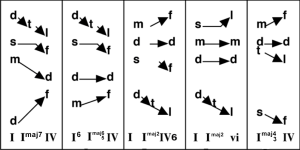
In minor, avoid the ti – le A2 by employing a i7 chord from natural minor.
6. In major, IVmaj7 moves to V. Resolution to ii is possible from the IVmaj2 chord.
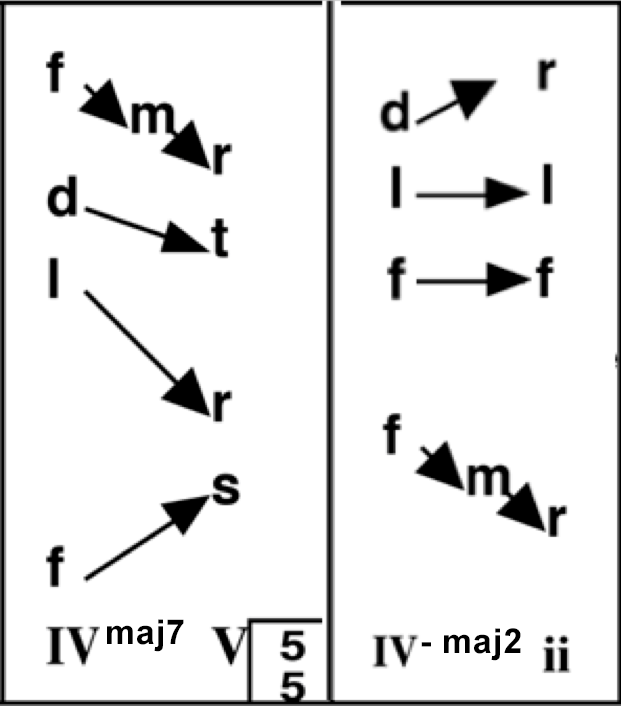
Note that when IVmaj7 moves to V, the V chord has a doubled 5th since doubling the root would result in parallel 5ths.
The progressions also work in minor.
The diatonic sequence (imperfect circle of fifths) with seventh chords
- In major keys: Imaj7 – IVmaj7 – viiø7 – iii7 – vi7 – ii7 – V7 – I
- In minor keys: i7 – iv7 – VII7 – IIImaj7 – VImaj7 – iiø7 – V7 – i
In the three voice examples below, note that the 3rd and 7th of the chords alternately become common tones.
Root position: 7th chord to 7th chord
The 7th of the chord can be a passing tone (#1 below) or it can be introduced as a common tone from the 3rd of the previous chord (#2 below).
If every chord in the diatonic sequence is a seventh chord, the chords alternately will become complete and incomplete, and every chord 7th will resolve to the 3rd of the next chord.
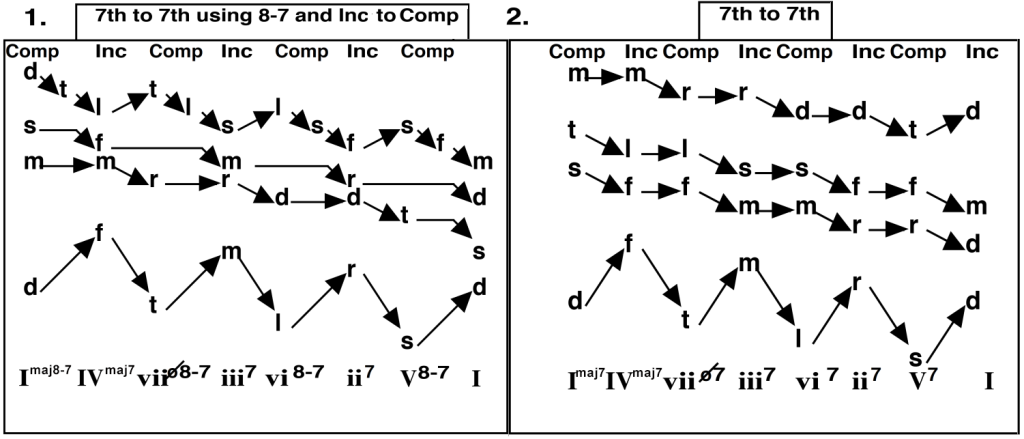
Inversions: ![]() to 2, 7 to
to 2, 7 to ![]()
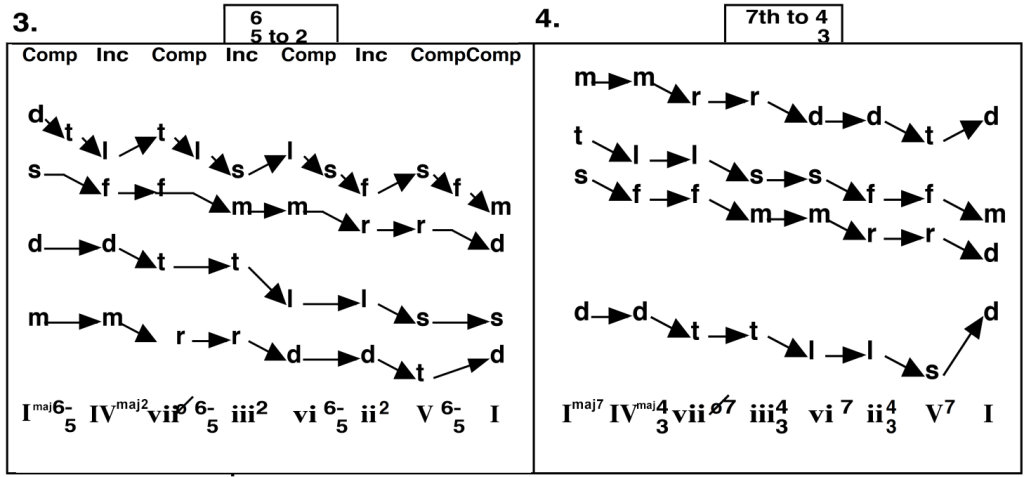
In la-minor, the vi7 of the relative major key is simply renumbered as a i7 chord. All subsequent connections are the same as in major except at the final cadence with the raised leading tone (si) of harmonic minor. For example:
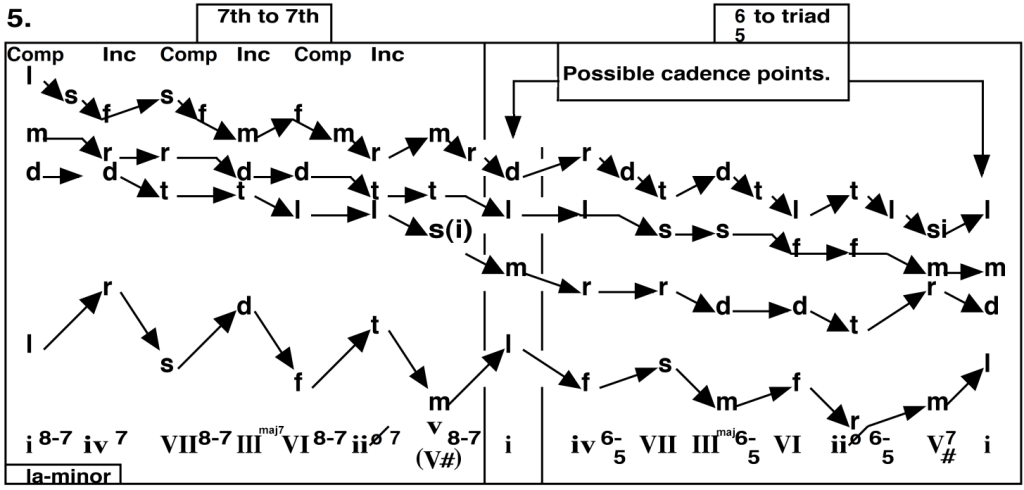
Practice 3
Practice 4
